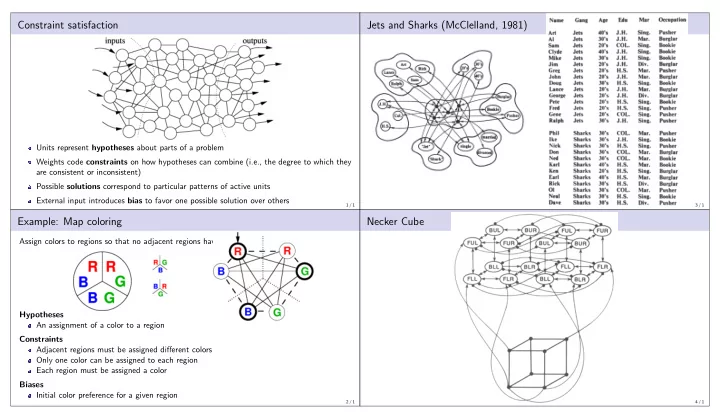

Constraint satisfaction Jets and Sharks (McClelland, 1981) Units represent hypotheses about parts of a problem Weights code constraints on how hypotheses can combine (i.e., the degree to which they are consistent or inconsistent) Possible solutions correspond to particular patterns of active units External input introduces bias to favor one possible solution over others 1 / 1 3 / 1 Example: Map coloring Necker Cube Assign colors to regions so that no adjacent regions have the same color. Hypotheses An assignment of a color to a region Constraints Adjacent regions must be assigned different colors Only one color can be assigned to each region Each region must be assigned a color Biases Initial color preference for a given region 2 / 1 4 / 1
Necker cube settling Goodness surface in state space State space A high-dimensional space with a dimension for each of n units in the network Each unit’s activity (state) can be interpreted as a coordinate along its corresponding axis/dimension At any instant in time, the current pattern of activity over the entire network corresponds to a particular n -dimensional point in the space As units update their states, the point moves in state space Goodness surface Each instantaneous pattern of activity has a corresponding “goodness” value Add an additional ( n +1st) dimension to state space so that the goodness of each point (activity pattern) can be plotted “above” it The set of goodness values corresponding to all possible activity patterns forms a continuous surface “above” state space 5 / 1 7 / 1 Maximizing Goodness (= minimizing Energy) Goodness surface (Necker cube) Global measure of degree to which activations satisfy weight constraints � G ( Goodness = − Energy ) = a i a j w ij i < j How should unit k behave locally so as to increase global Goodness? Set a k = 1 if G a k =1 > G a k =0 (or, equivalently, G a k =1 − G a k =0 > 0) � � G a k =1 = a i w ik + a i a j w ij i i < j � = k � = G a k =0 a i a j w ij i < j � = k � G a k =1 − G a k =0 = a i w ik i Set a k = 1 if � i a i w ik > 0 (= binary threshold unit ) Sigmoid units : increase activation as net input increases (monotonicity) 6 / 1 8 / 1
Goodness surface with input to front face (left cube) 9 / 1
Recommend
More recommend